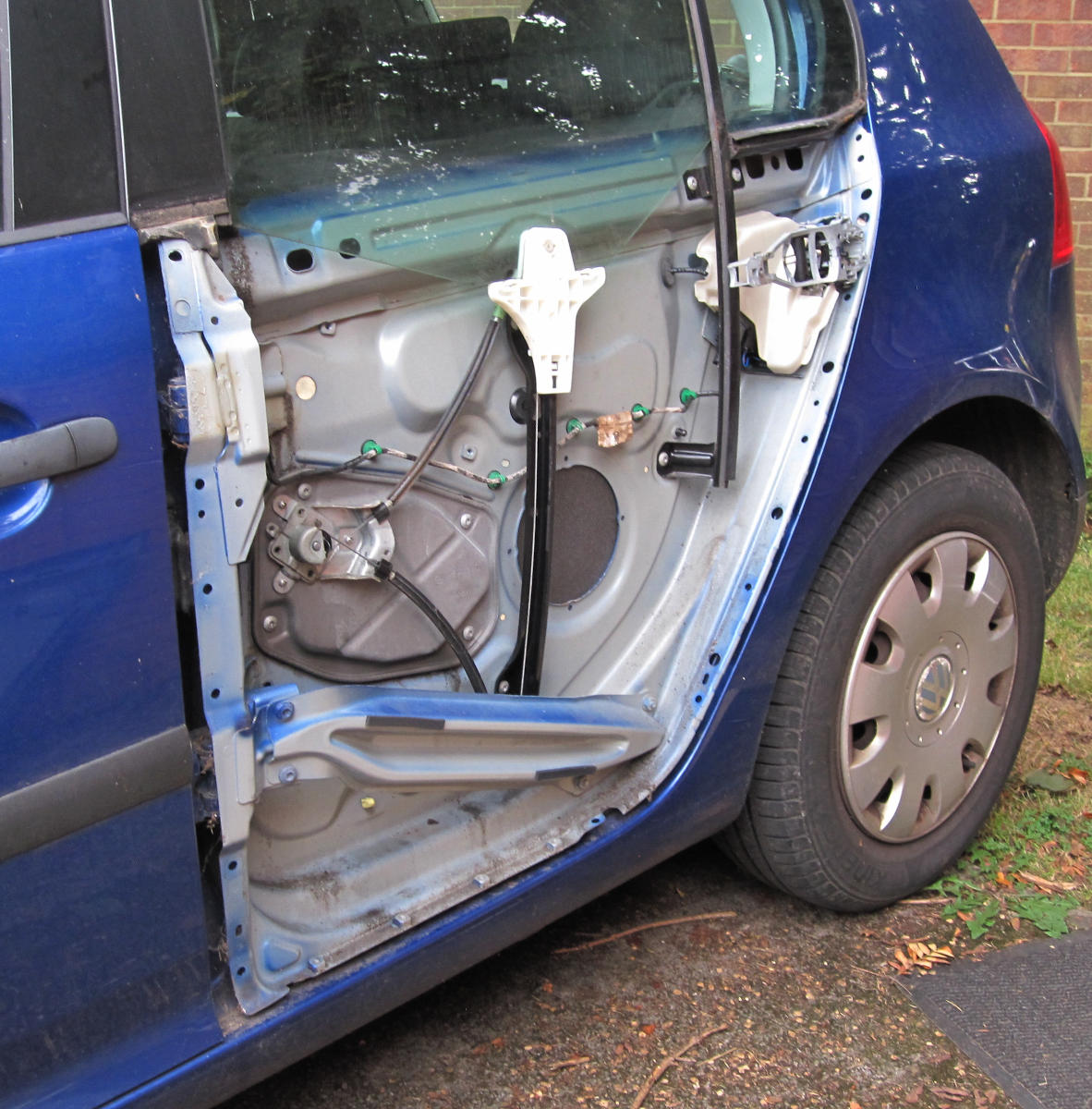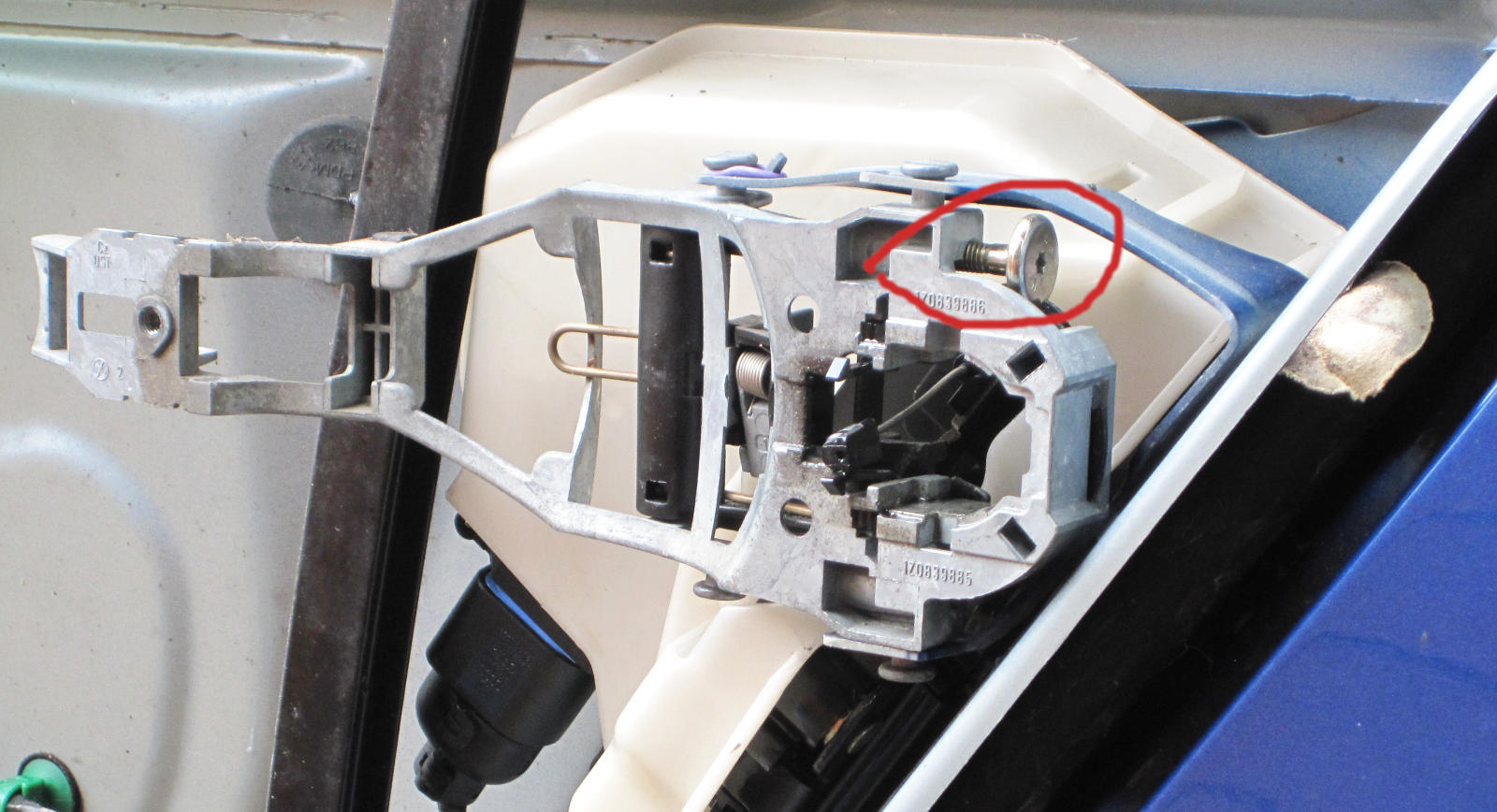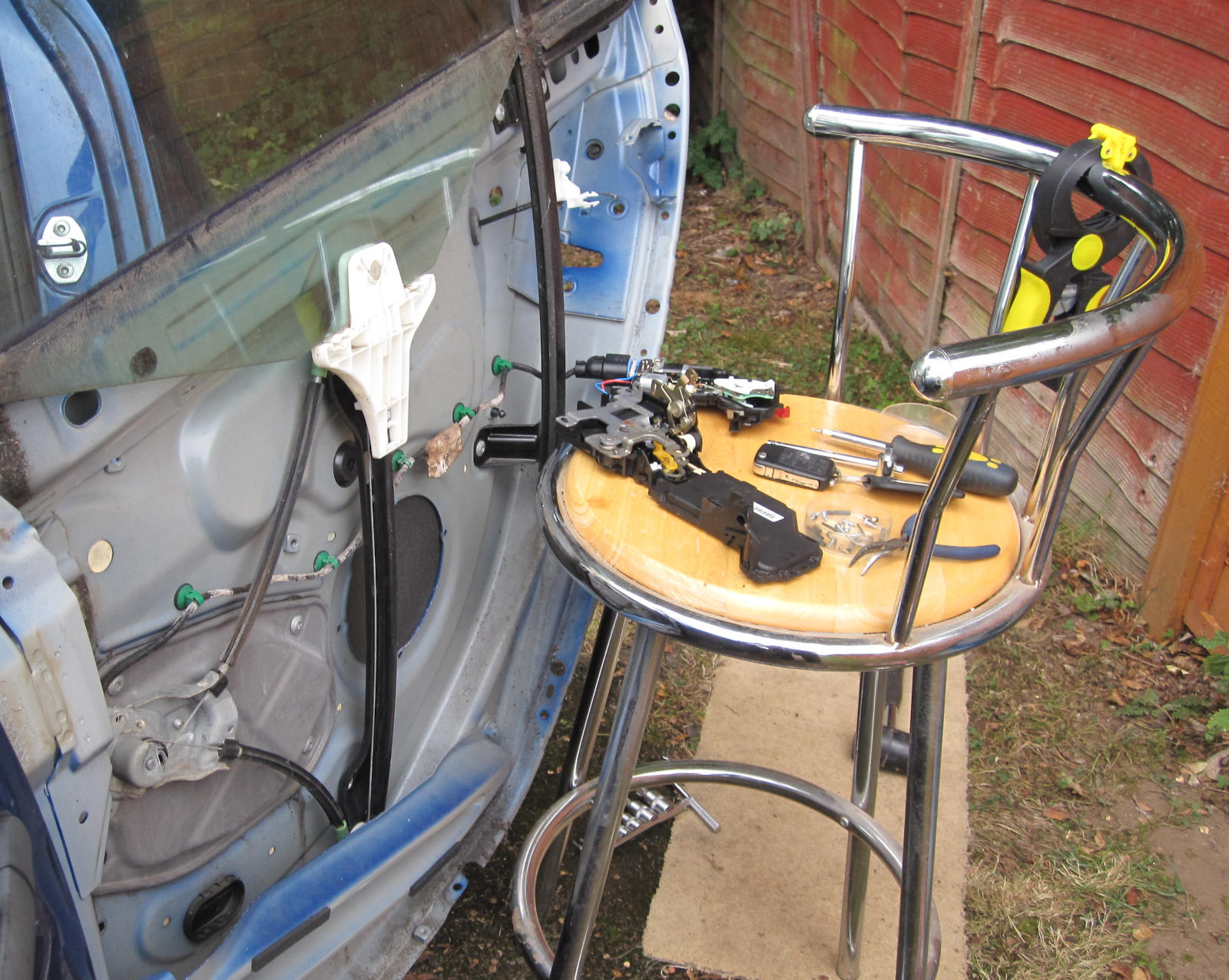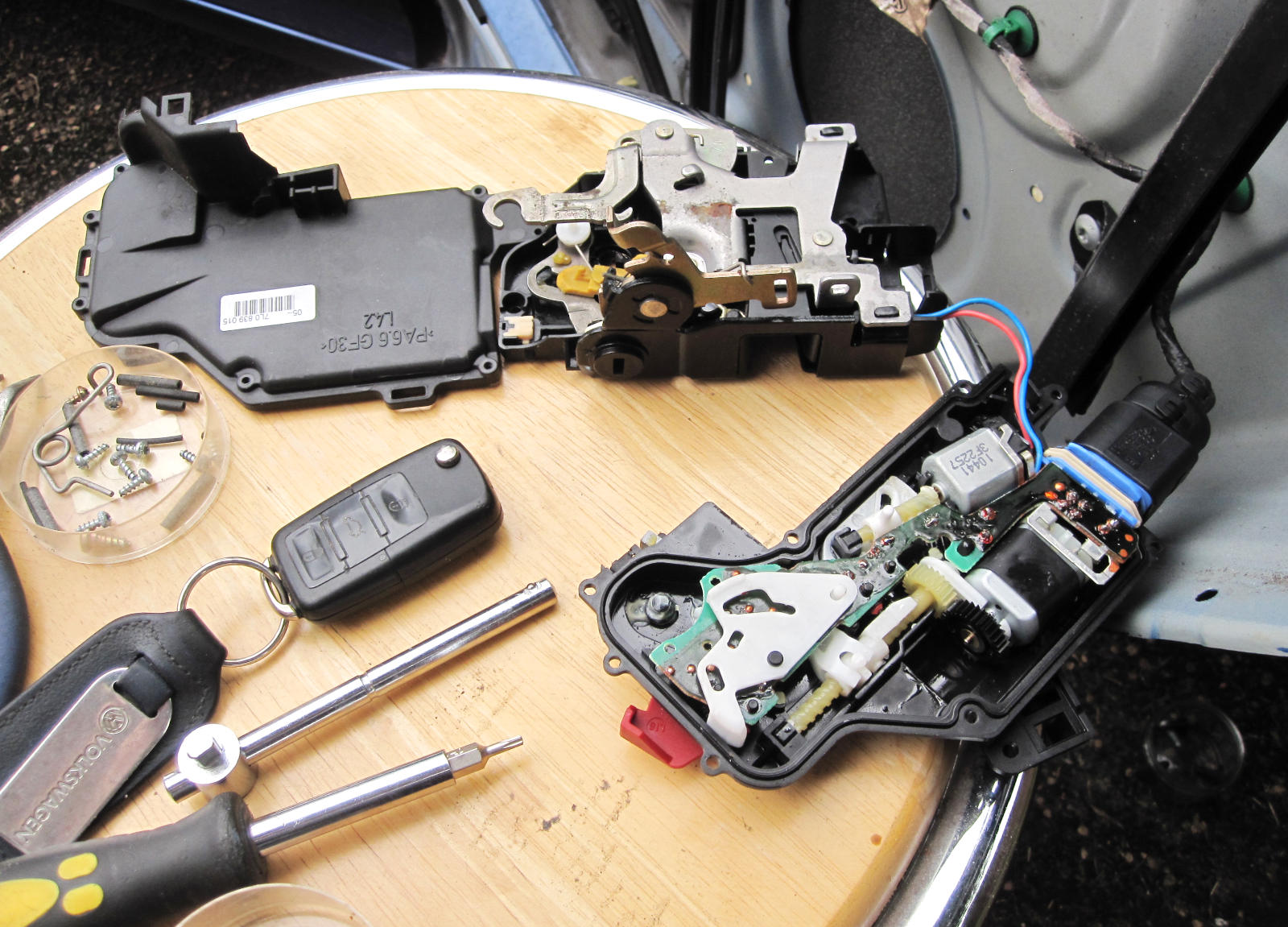It is often assumed, by those who don’t engage in car maintenance, that fixing the engine must be the most difficult task. However, in my experience the areas which give the greatest difficulty are either parts of the suspension which – being exposed to the road – become badly rusted or, worse of all, doors!
The people who design engines organise for the thing to be held together with a sensible sequence of bolts which can be clearly seen and reasonably readily removed. Door designers however, delight in obscure hidden clips which will release if you apply a lot of force in just the right place and break irreparably if you apply a modest amount of force in the wrong place, together with complex release mechanisms which have to operated entirely by touch.
It was therefore with some trepidation that I approached a problem with the locking mechanism on the rear nearside door of my Mk 5 Golf. The basic problem was that the door often wouldn’t unlock or (more annoyingly) couldn’t be made to lock. On my Mk 4 Fiesta, the doors can all be locked manually from the inside but on the Golf only the driver’s door can be manually locked (via the key) and all the others need the central locking to be working.
The project got off to a poor start when I failed to properly read the Haynes manual and presumed that as on the Fiesta, lock access would need me to remove the internal door trim which I did after a great amount of cursing of the offending clips. Unfortunately, this didn’t help in the slightest!
In fact one needs to remove the outer door panel and this was quite extraordinarily hard. The panel itself is help on with a large number of screws round the edge, but unfortunately it won’t come off without first removing the door handle and this is really difficult.
The driver’s door obviously contains a physical lock so that you can unlock the door with the key if all else fails. The door mechanism on the other doors is the same, but the lock is replaced by a blanking piece and this must be removed first. Anyone who wasn’t a loony would simply have had a screw which you remove from the edge of the door as is the case with the locks on house doors. But no, the process here is much more entertaining. The photo below shows the offending part of the mechanism. Remember that until you can remove the outer panel which can only be done once the handle is removed, this entire mechanism is invisible!
The key to this mechanism is the bolt which I have circled. This is accessed via a hole in the edge of the door normally covered by the tape which you can see on the right of the photo. The screw is so far inside the door that it is almost invisible through the hole so you have to engage you longest Torx driver by feel!
As you unscrew this bolt, it slowly rotates a cylinder around the lock blanking piece (you can’t really see this in the photo). Once you have completed the correct number of turns (I seem to remember that this is about 12) then you can pull out the blanking piece. This sounds no more than tricky, but there are some serious gotchas.
- If you haven’t removed the blanking piece before then you may well need to lever it out so don’t just keep turning until it become loose.
- If you unscrew the bolt too far then there is a danger that it will come loose and fall down inside the door. I have no idea what you would do then, but it may well involve cutting the door open.
- You have to keep the handle pulled out for the entire duration of this process or it won’t work.
With the blanking piece out, you can then unclip the wire which runs from the handle to the lock and remove the handle. This final step is something which various YouTubers make look very easy. They just pull gently on the handle, give a little flick and out it comes. I spent ages tugging and pulling at the blasted thing and have no idea what combination of pulling, turning and cursing finally caused it to come out.
Finally, with this done I was able to remove the door outer skin, unclip the handle mechanism with its loony locking cylinder and remove the lock mechanism itself which is behind the white plastic cover.
The lock mechanism consists of two parts; the actual lock itself and the electrical system for the central locking. I separated the two and laid them out on a stool next the door so that I could watch the mechanism function.
You will note that the central locking mechanism contains two motors. The larger actually locks the door whilst the smaller one is for the double locking feature (i.e. so that the door can’t be opened from the inside by breaking the glass the pulling the internal handle).
It was whilst experimenting with this mechanism that I discovered something about the locking sequence which I hadn’t realised before. On my old Fiesta, one click of the lock button on the key fob locks the door whilst a second one applies the double locking. So, more clicks is more locking and this makes sense to me. However, it clearly doesn’t make sense to the Germans as on the Golf one click locks and double locks whilst the second releases the double locking. So in this case more clicking is less locking. I have been double clicking the lock button for all the years that I have had the car and will now try to learn not to!
So, what was wrong with the lock? Well, so far as I could see, nothing! I suspect that the problem was entirely one of inadequate lubrication. After checking all the connections, solder joints and microswitches I resorted to just applying liberal amounts of oil and it seemed to be OK again.
I then had to put the whole damn thing back together again remembering that when you do so you have to set a special “setting spring” which gets released the first time you pull the handle. So far as I can understand this is something to do with setting the handle tension. The handle itself was as difficult to snap back into place as it had been to get out!
One final point that might be worth noting. You might be able to see just poking out from behind the central locking unit a bit of red plastic. This is a large lever which rotates with the state of the lock and it turns out that it exists to allow the door to be locked and unlocked in a crisis where the central locking has failed.
In the edge of the door there is a blanking plug. With this removed the lever can be pushed with a screwdriver to lock the door which can then be shut in the locked state.
Similarly, and for the rather worse case where the door can’t be unlocked and thus can’t be opened to allow access to fix the lock, there is another access hole. This can be reached by removing the door inner trim (which is presumably possible with the door closed but I bet it’s tricky) and again the red lever can be moved with a screwdriver to unlock the door.



